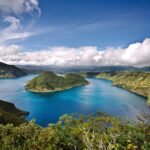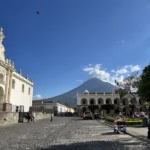Table of Contents
1. Introduction: Why Visit Guatemala
Guatemala is often called the “Land of Eternal Spring” thanks to its pleasant year-round climate. It’s a country that offers something for everyone—ancient Mayan ruins, lush jungles, colonial towns, active volcanoes, and vibrant indigenous traditions. Travelers seeking culture, adventure, and authenticity will find Guatemala to be a hidden gem of Central America.
2. Geography and Climate
Guatemala is located in Central America, bordered by Mexico, Belize, Honduras, and El Salvador. Its terrain ranges from volcanic highlands to tropical lowlands, offering a variety of climates.
Highlands (Antigua, Lake Atitlán): Cool and temperate.
Lowlands (Tikal, Petén): Hot and humid.
Pacific Coast: Warm and tropical.
3. Brief History of Guatemala
2000 BC – 900 AD: Rise of the Mayan civilization.
1524: Spanish conquest led by Pedro de Alvarado.
1821: Independence from Spain.
20th century: Civil war (1960–1996).
Today: A democratic republic with rich culture and growing tourism.
4. Mayan Civilization and Heritage
Guatemala was the heart of the ancient Maya civilization. Cities like Tikal, El Mirador, and Yaxhá showcase advanced architecture, astronomy, and writing. Even today, 40% of Guatemalans identify as Mayan, keeping traditions alive.
5. Colonial Era and Modern Guatemala
Spanish influence is seen in Antigua’s colonial architecture and Catholic traditions. Today, Guatemala blends Mayan roots with Spanish colonial heritage, creating a unique cultural fusion.
6. Language and People
Official language: Spanish.
Over 20 Mayan languages (K’iche’, Q’eqchi’, Kaqchikel, etc.).
Guatemalans are known for their warmth, hospitality, and resilience.
7. Religion and Festivals
Predominantly Catholic and Evangelical Christian, with Mayan spiritual practices intertwined.
Semana Santa (Holy Week in Antigua): World-famous Easter processions.
Day of the Dead (Sumpango Kite Festival): Giant colorful kites flown to honor ancestors.
8. Culture, Art, and Music
Textiles: Handwoven with traditional patterns and colors.
Marimba: National instrument.
Art: A mix of Mayan symbolism and modern creativity.
9. Guatemalan Cuisine
Pepián: Rich meat stew.
Kak’ik: Spicy turkey soup.
Tamales: Corn dough wrapped in banana leaves.
Atol: Sweet corn-based drink.
Street food like pupusas and tostadas are must-tries.
10. Top Cities and Towns to Visit
Guatemala City
Capital, museums, nightlife.
Antigua Guatemala
UNESCO World Heritage Site, cobblestone streets, baroque churches.
Quetzaltenango (Xela)
Cultural hub, language schools, access to volcano hikes.
Flores
Gateway to Tikal ruins.
Chichicastenango
Famous indigenous market.
11. Natural Wonders of Guatemala
Lake Atitlán: Surrounded by volcanoes and Mayan villages.
Semuc Champey: Turquoise natural pools in the jungle.
Pacaya Volcano: Popular volcano hike with lava views.
Sierra de las Minas: Rich in biodiversity.
12. Mayan Ruins and Archaeological Sites
Tikal: Largest and most famous site.
El Mirador: Remote city with the largest pyramid by volume.
Yaxhá: Less crowded ruins with stunning lake views.
Uaxactún: Ancient observatory.
13. Adventure Activities in Guatemala
Hiking: Acatenango Volcano for sunrise over Fuego.
Coffee Tours: Learn about Guatemala’s famous coffee.
Kayaking: Lake Atitlán and Río Dulce.
Ziplining and Caving: Adventure parks and Lanquín caves.
14. Wildlife and National Parks
Guatemala has diverse ecosystems with jaguars, howler monkeys, toucans, and quetzals (the national bird).
15. Traditional Clothing and Textiles
Each Mayan community has unique huipiles (embroidered blouses) and woven textiles that tell stories of ancestry.
16. Economy and Local Markets
Markets like Chichicastenango are essential for trade, selling textiles, crafts, and local food. Agriculture, coffee, and tourism drive the economy.
17. Best Time to Visit Guatemala
Dry Season (Nov–April): Best for travel.
Rainy Season (May–Oct): Lush landscapes, fewer tourists.
18. How to Get to Guatemala and Around
Flights: Arrive at La Aurora International Airport (Guatemala City).
Transport: Chicken buses, shuttles, taxis, domestic flights.
19. Travel Costs and Budget Guide
Budget: $30–$50/day (hostels, street food, buses).
Mid-range: $70–$120/day.
Luxury: $200+/day (boutique hotels, guided tours).
20. Safety and Responsible Tourism
Stick to tourist routes.
Use registered guides.
Respect local customs and communities.
21. Sample Itineraries
5-Day Trip
Antigua + Pacaya Volcano + Lake Atitlán.
7-Day Trip
Antigua, Atitlán, Chichicastenango, Tikal.
10-Day Trip
Antigua, Lake Atitlán, Xela, Semuc Champey, Flores/Tikal.
Conclusion
Guatemala is a land of volcanoes, lakes, Mayan ruins, and colorful traditions. From hiking to ancient temples to sipping coffee in colonial Antigua, it offers rich experiences for adventurers and culture lovers alike.
FAQs
Q1. Is Guatemala safe for tourists?
Yes, but stick to tourist routes, use trusted transportation, and stay informed.
Q2. What is the best time to visit Guatemalas?
The dry season (November–April) offers the best weather.
Q3. Do I need a visa for Guatemala?
Many nationalities (US, EU, Canada) get visa-free entry for up to 90 days.
Q4. What currency is used in Guatemala?
The Guatemalan quetzal (GTQ).
Q5. What are the top attractions in Guatemala?
Antigua, Lake Atitlán, Tikal, Semuc Champey, and Chichicastenango Market.
Q6. How do I travel around Guatemala?
By shuttle buses, domestic flights, or chicken buses (for adventurous travelers).
Q7. Is Guatemala good for budget travel?
Yes, it’s one of the most affordable destinations in Central America.
Q8. What foods should I try in Guatemala?
Pepián, kak’ik, tamales, and atol.











